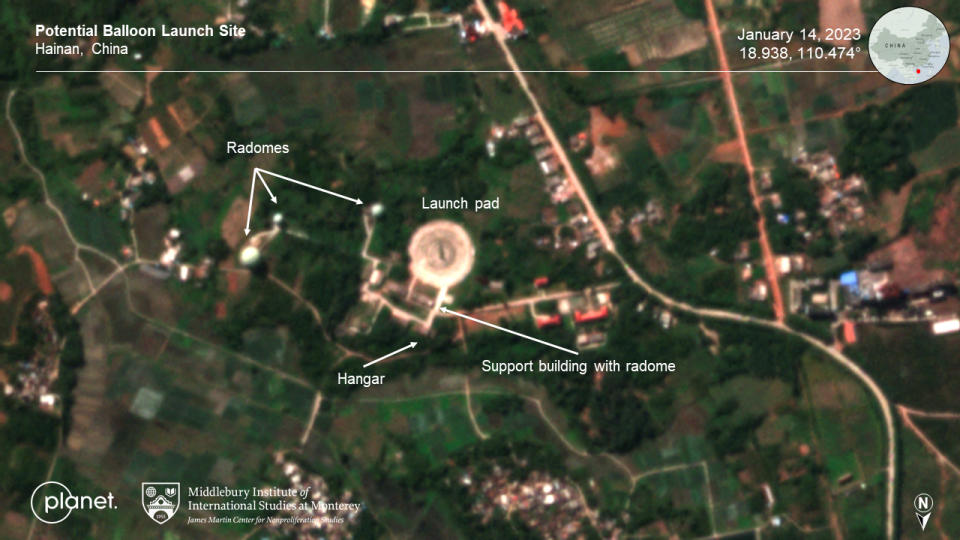Satellite Images Reveal Chinese Balloon Bases

China’s spy balloon took off from a base on Hainan Island along the country’s southern coast, American intelligence reportedly believes. New satellite imagery obtained by researchers shows that the island is home to a balloon launch facility.
Researchers at the Middlebury Institute of International Studies identified the facility in satellite imagery captured by space imaging firm Planet Labs. It’s unclear if the facility identified in the imagery is related to the spy balloon which crossed the U.S. earlier this month. But the discovery follows reporting from The Washington Post late Tuesday that U.S. intelligence officials now think the People’s Liberation Army launched the infamous spy balloon from Hainan with the intent of spying on U.S. military bases in the Pacific.
More from Rolling Stone
U.S. Shoots Down Claim That American Balloons Have Been Soaring Over China
Former President Accused of Attempting Coup Calls Biden 'Most Corrupt President in American History'
SNL Airs Hilarious Interview With Bowen Yang's Chinese Spy Balloon
Based on the Post’s identification of the island as the likely origin of the balloon, “we believe this is the best launch site candidate on the island, especially as it has previously hosted aerostats,” says Sam Lair, a Middlebury Institute of International Studies (MIIS) researcher who helped analyze the imagery for Rolling Stone.

Lair, who identified the facility along with colleagues Michael Duitsman and Tricia White, says his team also found imagery of the location hosting airships in Google Earth.
“The entire facility is surrounded by a perimeter security fence and also includes three large radomes,” used to house radar antennas, says Lair. The 140 meter launch pad also has what appears to be launch equipment visible in the satellite imagery, which was captured in mid-January.
The Middlebury team was able to identify the Hainan site as a balloon launch facility in part because of its similarity to another Chinese launch site they found in Dorbod Banner, near China’s northern border with Mongolia.

The circular pad for launching balloons, high-bay hangar for storing them, and support buildings with small radome at the Hainan site are all similar to the Dorbod Banner facility.
That facility in China’s Inner Mongolia province was first built in mid-2016 and features a large 350- to 400-meter launchpad, which was expanded in 2021.
“The pairing of a hangar, support building, and a launch pad is characteristic of balloon launch sites observed in other countries including the U.S., Australia, and New Zealand,” says Lair.

Chinese officials haven’t said much about the Darbod Banner facility, who owns it, or how they plan to use it. But there are access restrictions visible in the satellite imagery that make the imagery analysts believe it’s linked to China’s People’s Liberation Army. “We suspect that it may be a military facility, but that’s based on the existence of the perimeter security fence as well as the security fence around the collection buildings,” says Lair.
The Chinese balloon which transited the U.S. in February was roughly the size of two to three buses and was not the first to allegedly violate American airspace, according to National Security Council spokesman Adm. John Kirby. Chinese spy balloons drifted into the U.S. at least three times during the Trump administration “for brief periods” much shorter than the trip by the Chinese balloon shot down over the Atlantic Ocean.
China has claimed that the balloon shot down was merely a weather balloon for scientific research and accused the U.S. of flying its own spy balloons across China on 10 separate occasions.
Beijing is, not surprisingly, tight-lipped about its alleged balloon espionage program, but researchers like MIIS’s Eli Hayes have scoured Chinese-language academic literature and state propaganda to find clues about how academics there think and talk about known airship and balloon programs. In short: they can help supplement more expensive surveillance gear, like spy satellites.

In an unpublished paper from October 2021 shared with Rolling Stone, Hayes wrote that papers by Chinese academics working on airship research express “a widespread belief that airships can serve important roles as an affordable alternative to satellite capabilities in both civil and military functions” and can act as a relatively low-cost supplement or replacement to more conventional platforms in the fields of Intelligence, Surveillance, Reconnaissance (ISR), earth monitoring, and communications.”
Hayes has also identified a number of airship design teams from mentions in Chinese-language open source literature. The designers, which include academic institutions, nuclear weapons research institutes, and private aerospace companies like the China Aerospace Science and Industry Corporation and the Aviation Industry Corporation of China.
It’s still unclear how China is using these sites or whether they’re devoted to the kinds of intelligence-gathering that prompted the shoot down earlier this month. But the construction patterns identified by Middlebury at Hainan and Darbod Banner are already bringing China’s capabilities closer into focus.
Best of Rolling Stone

